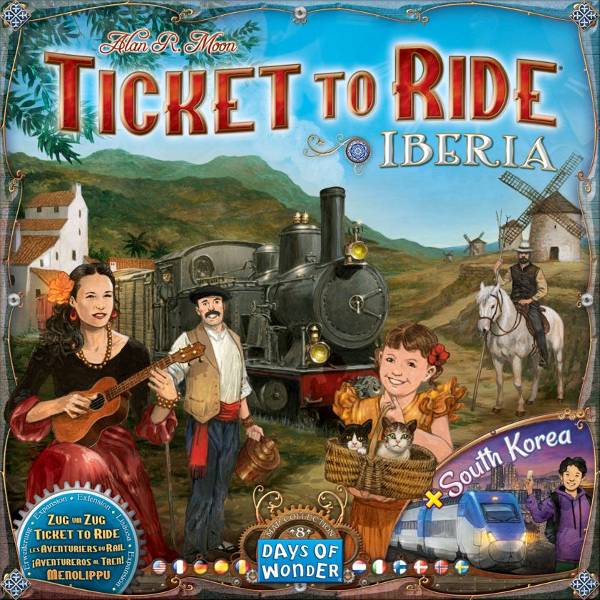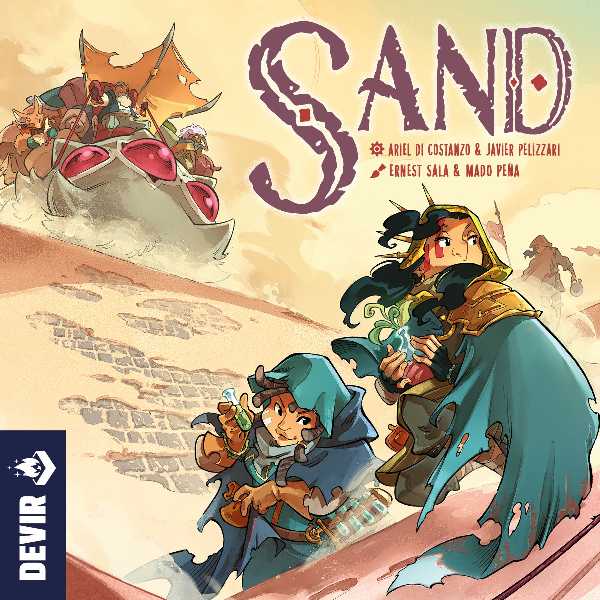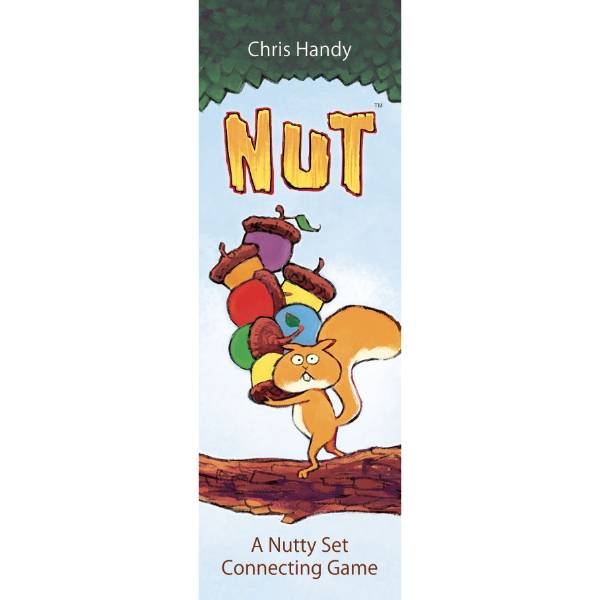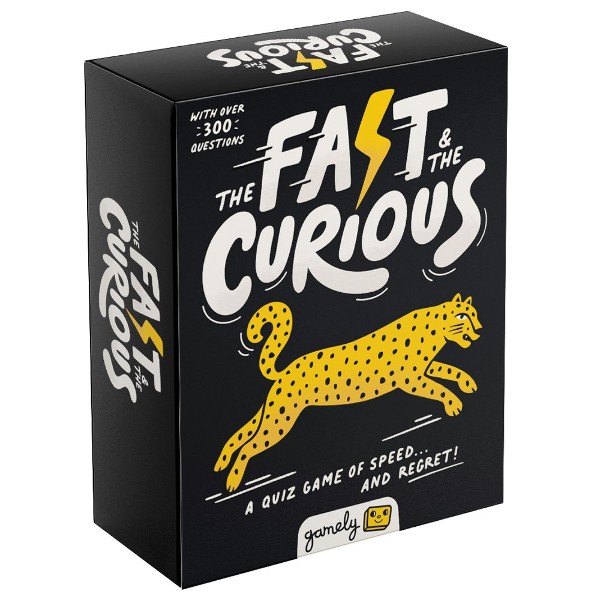About Gamewright Games:

I hadn’t heard of Gamewright Games before we were introduced to them at the Toy Fair back in January but I must say their games have totally won me over! Gamewright has been around since 1994 and was founded by four parents whose kids wanted great games. Their mission from the start has always been to create the highest quality family games with outstanding play-value.
One of our goals as a toy shop is to be able to provide honest and informed recommendations to our customers so of course that means we have to test all the games out ourselves (a real perk of the job as I really love proper family games!). Unfortunately Xander is too young for most (if not all) of the games we stock at the moment so Joel and I have had to play them on our own. I think most games are better the more players you have so I’d be interested in hearing from anyone who’s played these games as a family. If you’d like to borrow any of these games to test out, contact me on here or send me a message on Facebook!
Sleeping Queens
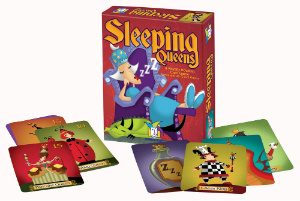 The aim of Sleeping Queens is to be the first player to collect a set number of Queens (this varies depending on how many players there are). You collect Queens by using Kings to awaken them. You can also play Knights to steal Queens from your opponents or use sleeping potions to put another player’s Queen back to sleep.
The aim of Sleeping Queens is to be the first player to collect a set number of Queens (this varies depending on how many players there are). You collect Queens by using Kings to awaken them. You can also play Knights to steal Queens from your opponents or use sleeping potions to put another player’s Queen back to sleep.
I like Sleeping Queens a lot. This game worked well with two players, which isn’t always the case, but I could also see it being really good for a family to play. The rules are very simple so the game is easy to learn. There is quite a lot of luck involved so this evens out the playing field between children and adults. One interesting aspect of this game is that it utilises simple arithmetic in game play. For example, when discarding cards you can do this by using simple equations (if you have a two, a three and a five, you can discard these as 2 + 3 = 5). Discarding as many number cards as possible is a good thing as this gives you the chance to pick up more useful cards like Kings or sleeping potions.
Sleeping Queens is recommended for ages 8+ (this is quite funny, as it was invented by a 6 year old!) and can be played by 2-5 players. A game should take around 15 minutes.
Gubs
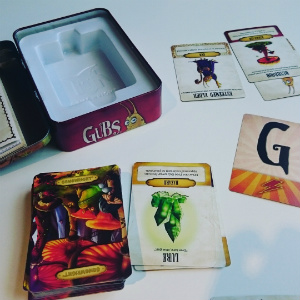 This is a really interesting game where you need to collect the most free Gubs to win. What I loved about this was the uncertainty of it all. Firstly, the game ends when the letters G, U and B have all been drawn from the pack and you never know when this is going to happen. Secondly, hazards and events mean that no player is ever safe – you could lose all of your Gubs at any moment!
This is a really interesting game where you need to collect the most free Gubs to win. What I loved about this was the uncertainty of it all. Firstly, the game ends when the letters G, U and B have all been drawn from the pack and you never know when this is going to happen. Secondly, hazards and events mean that no player is ever safe – you could lose all of your Gubs at any moment!
The artwork in this game is great and the storage tin is a nice touch.
One thing I would say is that the instructions appear vague at first, which makes you a bit unsure of how to start, but once you start playing it all falls into place very quickly. There’s no complicated scoring system at the end and it’s evident straight away who’s won.
This is a game that I would definitely choose to play again and again, even with just the two of us. Gubs is recommended for ages 10+ though I think that slightly younger children should be able to pick this up quite easily. A game takes around 20 minutes and can be played by 2-6 players.
Rat-a-Tat Cat
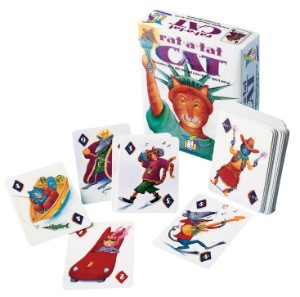 Rat-a-Tat Cat is a fun game where you have to try to get the lowest possible score across your hand of four cards. Your hand stays face-down at all times so you need to remember what numbers you have and decide whether or not to swap them for cards drawn from the deck. I like the use of memory in this game but there is also quite a bit of luck involved and some strategy too as the game ends when you think your hand is lower than your opponent’s and you shout “Rat-a-Tat Cat!”
Rat-a-Tat Cat is a fun game where you have to try to get the lowest possible score across your hand of four cards. Your hand stays face-down at all times so you need to remember what numbers you have and decide whether or not to swap them for cards drawn from the deck. I like the use of memory in this game but there is also quite a bit of luck involved and some strategy too as the game ends when you think your hand is lower than your opponent’s and you shout “Rat-a-Tat Cat!”
Another nice aspect of this game is that the play length is flexible. You can play for a set number of rounds, a set time or when one of the players reaches a set score.
This game is recommended for ages 6+ but there’s enough here to make it enjoyable for adults. It can be played by 2-6 players and takes around 20 minutes to play.
Rat-a-Tat Cat won a Mensa Select award for games which are original, challenging and well designed.
Super Tooth
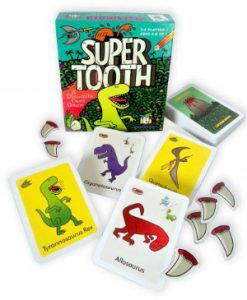 The object of Super Tooth is to collect matching sets of plant-eater dinosaurs which you can then exchange for Super Tooth tokens. The first player to get two Super Tooth tokens, or five tokens in a 2 player game, wins. You’ll be stopped by meat-eater dinosaurs and there are plenty of twists along the way in the form of events such as the Tyrannosaurus Rex where all players have to give their hands to the active player who shuffles and re-deals them.
The object of Super Tooth is to collect matching sets of plant-eater dinosaurs which you can then exchange for Super Tooth tokens. The first player to get two Super Tooth tokens, or five tokens in a 2 player game, wins. You’ll be stopped by meat-eater dinosaurs and there are plenty of twists along the way in the form of events such as the Tyrannosaurus Rex where all players have to give their hands to the active player who shuffles and re-deals them.
This game will certainly appeal to young dinosaur fans and it’s very straightforward to pick up. The graphics are lovely and bright and the Plateosaurus holding a plate really made me chuckle. I must admit that I struggled to pronounce some of the dinosaurs’ names but kids seem to be far better at these things than I am!
Super Tooth is recommended for ages 6+ and can be played by 2 – 4 players. It’s a quick game with play time of around 15 minutes.
Dragonwood
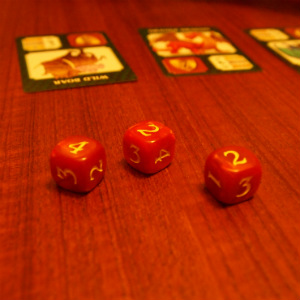 Dragonwood is one of Gamewright’s newest games. While all of the games mentioned above are pretty much pocket-sized, Dragonwood comes in a larger box because of the dice. I love the artwork in this game and the pearlescent dice are just beautiful. Along with Gubs and Sushi Go, I would say this is most likely to be enjoyed by adults, even when playing without children.
Dragonwood is one of Gamewright’s newest games. While all of the games mentioned above are pretty much pocket-sized, Dragonwood comes in a larger box because of the dice. I love the artwork in this game and the pearlescent dice are just beautiful. Along with Gubs and Sushi Go, I would say this is most likely to be enjoyed by adults, even when playing without children.
Gamewright describes Dragonwood as “A Game of Dice & Daring” which sums it up really well. In short, you use your Adventurer cards to determine how many dice you can roll to attempt to capture Creatures. At the end of the game, the player with the most Victory Points (as found on their captured Creatures) wins. What’s really good about Dragonwood is that there’s an element of risk in determining how many dice to roll and you can use probability to help with this. I hope this doesn’t sound too complicated, as this game is very easy to learn and play, which is true for all of the Gamewright games we’ve tried so far.
Dragonwood is recommended for ages 8+, can be played by 2-4 players and takes around 20 minutes to play a game. Like Rat-a-Tat Cat, Dragonwood is also a Mensa Select award winner.
Sushi Go!
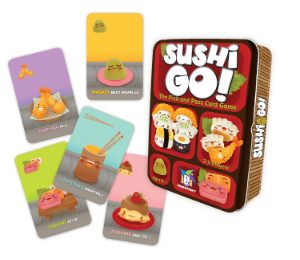 Sushi Go! comes in a handy storage tin and the illustrations are super cute. Of all the games covered here, this is the only one that I thought needed to be played with more than two players as it’s a bit too easy to keep track of which types of cards your opponent is trying to collect.
Sushi Go! comes in a handy storage tin and the illustrations are super cute. Of all the games covered here, this is the only one that I thought needed to be played with more than two players as it’s a bit too easy to keep track of which types of cards your opponent is trying to collect.
Sushi Go! is an incredibly popular game (check out reviews on Amazon). I really need to try playing this with more people at some point soon and revisit this blog post.
This 20 minute game can be played by 2-5 players (though we recommend playing with more than two) and is suitable for ages 8+.
We can highly recommend all of the Gamewright Games we’ve played so far. We haven’t yet tried Forbidden Island and Forbidden Desert but can’t wait as they’re both supposed to be great.
Have you got a favourite game from Gamewright? We’d love to hear from you so let us know in the comments below.
♥ Lindsay




